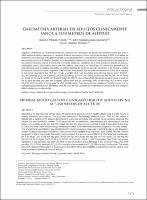Gasometría arterial en adultos clínicamente sanos a 3350 metros de altitud.
Related Resource(s)
https://rpmesp.ins.gob.pe/index.php/rpmesp/article/view/83Date
2014-07Author(s)
Pereira-Victorio, César J.
Huamanquispe-Quintana, John
Castelo-Tamayo, Luis E.
Metadata
Show full item recordAlternate title
Arterial blood gases in clinically healthy adults living at 3,350 meters of altitude
Abstract
Objetivo. Determinar los valores gasométricos arteriales de normalidad, en adultos clínicamente sanos que viven a
3350 metros de altitud. Materiales y métodos. Estudio realizado en Cusco, distrito de Santiago a 3350 m de altitud, se
determinó una muestra de 118 sujetos mediante un estudio piloto previo, seleccionados por muestreo por conveniencia; las
personas tenían entre 20-59 años de edad, sin antecedentes patológicos pulmonares, cardiovasculares o hematológicos,
con práctica deportiva menor a 60 min/día, sin hábito tabáquico, residentes los 5 años previos al estudio en Cusco y
catalogados como “clínicamente sanos” por dos médicos internistas y un neumólogo. La recolección gasométrica fue
estandarizada, para el análisis estadístico se empleó medidas de tendencia central y dispersión, t de Student y análisis
de varianza, correlación lineal y regresión lineal múltiple. Resultados. Las mujeres conformaron el 57,6% de la muestra;
la frecuencia respiratoria fue 16,2 por minuto, y el IMC 24,8. Los resultados gasométricos fueron: pH=7,42mEq/L;
pO2
=61,08mmHg; pCO2
=30,62mmHg; pAO2
=62,52mmHg; SO2
=91,13%; AaDO2
=0,0mmHg; Hto 44,22%; Hb 14,74mg/
dL; CaO2 18,18 vols/%; HCO3 19,74mmol/L; pO2
/FiO2
290,79 y Anion Gap 20,99. Mediante regresión lineal, a partir de
los 20 años de edad, por cada año cumplido, “disminuyen” pO2
(0,122mmHg), pAO2
(0,08mmHg), SO2
(0,05%), índice
pO2
/FiO2
(0,571mmHg); e “incrementa” la pCO2 (0,056mmHg). Conclusiones. Los resultados hallados respecto a los
parámetros gasométricos son diferentes a los del nivel de mar y pueden ser empleados en poblaciones que habitan a
altitud semejante a la del estudio. Objectives. To determine the normal values of arterial blood gases in clinically healthy adults living at 3,350 meters of altitude. Materials and methods. The study was conducted in the Santiago district of Cusco, Peru at 3,350 meters of altitude with a sample of 118 subjects determined in a previous pilot study and selected by convenience sampling. The sample included individuals between 20-59 years old with no pulmonary, cardiovascular and hematological medical history, who practice sports less than 60 minutes per day, non smoking, have resided at least 5 years prior to the study in Cusco and were characterized through clinical examination by two internists and pulmonologists as “clinically healthy”. The arterial blood gas collection was standardized for statistical analysis measures of central tendency and dispersion. Student’s t-tests and analysis of variance, linear correlation and multiple linear regression were applied. Results. Women comprised 57.6% of the sample. Respiratory rate averaged 16.2 per minute and BMI 24.8. The blood gas results were: pH 7.42 mEq/L; pO2 61.08 mm Hg; pCO2 30.62 mm Hg; pAO2 62.52 mm Hg; SO2 91.13%; AaDO2 0.0 mm Hg; Hto 44.22%; Hb 14.74 mg/dL; CaO2 18.18 vol%; HCO3 19.74 mmol/L; pO2/FiO2 290.79 and Anion Gap 20.99. Using linear regression, it was observed that each year from the age of 20, there was a decrease in pO2 (0.122 mm Hg), pAO2 (0.08 mm Hg), SO2 (0.05%), index pO2/FiO2 (0.571 mm Hg) and an increase in pCO2 (0.056 mm Hg). Conclusions. The results found with respect to blood gases in this population are different from those residing at sea level and can be used to study other populations residing at a similar altitude.
Collections
- Artículos científicos [890]






